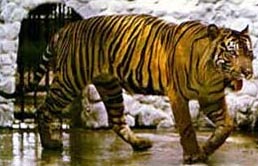THE TIGER - Panthera
tigrisAlthough
scientists no longer classify tigers into subspecies, these names are commonly
used to describe "races" of tigers from different regions that have slightly
different physical characteristics. There were 8 subspecies of Tiger at the
beginning of the 20th century. 3 are now extinct, leaving 5 existing
subspecies. Here they are...
Bengal
(subspecies tigris)
The Bengal tiger is the
most populous type, with between 2500 and 4700 remaining in the wild. Most
live in the mangrove forests of the Sundarbans in eastern India and
Bangladesh. Some also live in the neighboring countries Bhutan, Myanmar, and
Nepal . There are about 333 Bengal tigers in captivity. Males typically weigh
around 500 pounds; the females about 300. All white tigers are male Bengals
and have a double recessive gene that causes the coloration. Official status:
ENDANGERED.
Indochinese
(subspecies corbett)
Indochinese tigers are
centered in Thailand, but also in surrounding countries - Myanmar, southern
China, Cambodia, Laos, Vietnam, and peninsular Malaysia. They are smaller and
darker than Bengal tigers, averaging around 400 pounds for males and 300 for
females. Males average about 9 feet long and females about 8 feet in length
(not counting the tail). Numbers in the wild are estimated to be in the range
1227-1785. There are about 60 in zoos. Official status: ENDANGERED.
Sumatran
(subspecies corbett)
The smallest and darkest
subspecies, Sumatran tigers are reddish and have closely spaced stripes. The
males average 250 lbs. About 400-500 remain in the wild, exclusively on the
Indonesian island of Sumatra. About 210 of this subspecies are captive around
the world. Official status: ENDANGERED.
Amur/Siberian
(subspecies altaica)
These guys are the
largest of the big cats, weighing in at 675 pounds and stretching a full 11
feet. The heaviest Siberian Tiger on record was 1025 pounds (Guiness Book of
World Records). Only about 360-470 exist in the wild and there are roughly 490
captive. Their habitat is mostly Northeastern Russian. Despite their size,
they have been known to jump as far as 33 feet. Official status: ENDANGERED.
For
more on Siberian tigers, see
www.siberian-tigers.com
- a general resource of information with numerous links to other Siberian
tiger sites.
South
Chinese
(subspecies amoyensis)
Unfortunately,
there are perhaps only 20-30 South Chinese tigers left in the wild and 47 in
Chinese zoos. They are found in central and eastern China. China joined CITES
in 1981 and passed the Wild Animal Protection Law of the People's Republic of
China in 1988. Official status: ENDANGERED.
and, the extinct ones...
Javan
(subspecies
sondaica)
The Javan tiger
once roamed the Indonesian island of Java. The last one was seen in 1972 and
is now believed to be extinct.
Caspian
(subspecies
virgata)
The Caspian tiger once
ranged from Turkey to Central Asia, including Iran, Mongolia, and Central
Russia. They went extinct in the 1950's.
Bali
(subspecies
balica)
The Bali tiger
existed on the island of Bali. The last one was killed in 1937. There are no
existing photos of a live Bali tiger.










